The AMD Ryzen 3 3300X and 3100 CPU Review: A Budget Gaming Bonanza
by Dr. Ian Cutress on May 7, 2020 9:00 AM ESTCPU Performance: System Tests
Our System Test section focuses significantly on real-world testing, user experience, with a slight nod to throughput. In this section we cover application loading time, image processing, simple scientific physics, emulation, neural simulation, optimized compute, and 3D model development, with a combination of readily available and custom software. For some of these tests, the bigger suites such as PCMark do cover them (we publish those values in our office section), although multiple perspectives is always beneficial. In all our tests we will explain in-depth what is being tested, and how we are testing.
All of our benchmark results can also be found in our benchmark engine, Bench.
Application Load: GIMP 2.10.4
One of the most important aspects about user experience and workflow is how fast does a system respond. A good test of this is to see how long it takes for an application to load. Most applications these days, when on an SSD, load fairly instantly, however some office tools require asset pre-loading before being available. Most operating systems employ caching as well, so when certain software is loaded repeatedly (web browser, office tools), then can be initialized much quicker.
In our last suite, we tested how long it took to load a large PDF in Adobe Acrobat. Unfortunately this test was a nightmare to program for, and didn’t transfer over to Win10 RS3 easily. In the meantime we discovered an application that can automate this test, and we put it up against GIMP, a popular free open-source online photo editing tool, and the major alternative to Adobe Photoshop. We set it to load a large 50MB design template, and perform the load 10 times with 10 seconds in-between each. Due to caching, the first 3-5 results are often slower than the rest, and time to cache can be inconsistent, we take the average of the last five results to show CPU processing on cached loading.
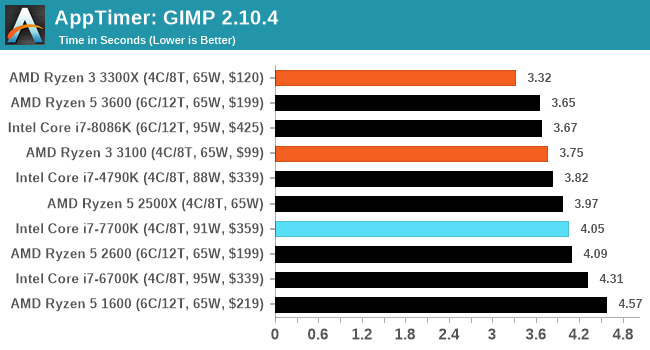
3D Particle Movement v2.1: Brownian Motion
Our 3DPM test is a custom built benchmark designed to simulate six different particle movement algorithms of points in a 3D space. The algorithms were developed as part of my PhD., and while ultimately perform best on a GPU, provide a good idea on how instruction streams are interpreted by different microarchitectures.
A key part of the algorithms is the random number generation – we use relatively fast generation which ends up implementing dependency chains in the code. The upgrade over the naïve first version of this code solved for false sharing in the caches, a major bottleneck. We are also looking at AVX2 and AVX512 versions of this benchmark for future reviews.
For this test, we run a stock particle set over the six algorithms for 20 seconds apiece, with 10 second pauses, and report the total rate of particle movement, in millions of operations (movements) per second. We have a non-AVX version and an AVX version, with the latter implementing AVX512 and AVX2 where possible.
3DPM v2.1 can be downloaded from our server: 3DPMv2.1.rar (13.0 MB)
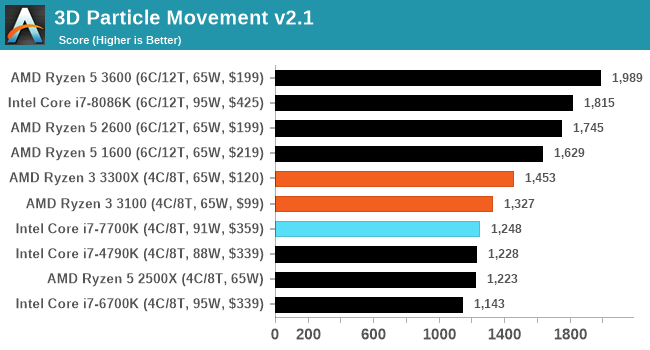
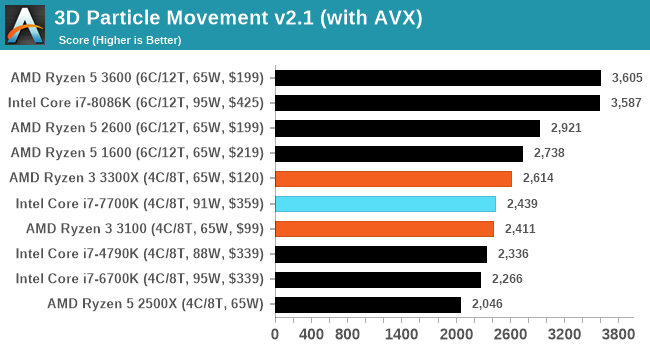
Dolphin 5.0: Console Emulation
One of the popular requested tests in our suite is to do with console emulation. Being able to pick up a game from an older system and run it as expected depends on the overhead of the emulator: it takes a significantly more powerful x86 system to be able to accurately emulate an older non-x86 console, especially if code for that console was made to abuse certain physical bugs in the hardware.
For our test, we use the popular Dolphin emulation software, and run a compute project through it to determine how close to a standard console system our processors can emulate. In this test, a Nintendo Wii would take around 1050 seconds.
The latest version of Dolphin can be downloaded from https://dolphin-emu.org/
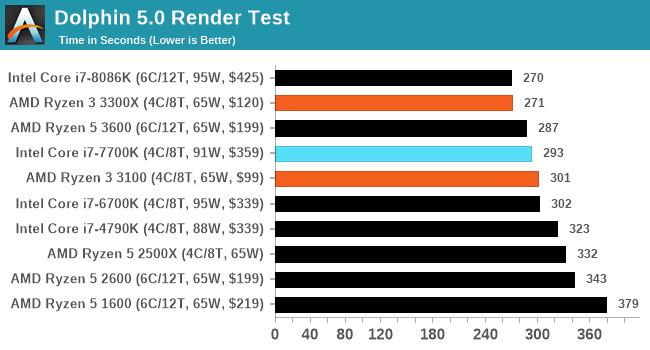
DigiCortex 1.20: Sea Slug Brain Simulation
This benchmark was originally designed for simulation and visualization of neuron and synapse activity, as is commonly found in the brain. The software comes with a variety of benchmark modes, and we take the small benchmark which runs a 32k neuron / 1.8B synapse simulation, equivalent to a Sea Slug.
Example of a 2.1B neuron simulation
We report the results as the ability to simulate the data as a fraction of real-time, so anything above a ‘one’ is suitable for real-time work. Out of the two modes, a ‘non-firing’ mode which is DRAM heavy and a ‘firing’ mode which has CPU work, we choose the latter. Despite this, the benchmark is still affected by DRAM speed a fair amount.
DigiCortex can be downloaded from http://www.digicortex.net/
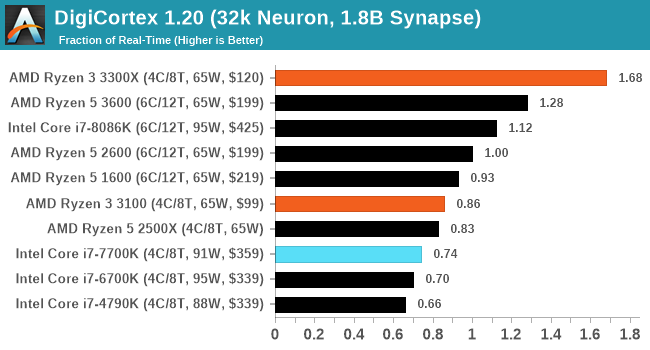
y-Cruncher v0.7.6: Microarchitecture Optimized Compute
I’ve known about y-Cruncher for a while, as a tool to help compute various mathematical constants, but it wasn’t until I began talking with its developer, Alex Yee, a researcher from NWU and now software optimization developer, that I realized that he has optimized the software like crazy to get the best performance. Naturally, any simulation that can take 20+ days can benefit from a 1% performance increase! Alex started y-cruncher as a high-school project, but it is now at a state where Alex is keeping it up to date to take advantage of the latest instruction sets before they are even made available in hardware.
For our test we run y-cruncher v0.7.6 through all the different optimized variants of the binary, single threaded and multi-threaded, including the AVX-512 optimized binaries. The test is to calculate 250m digits of Pi, and we use the single threaded and multi-threaded versions of this test.
Users can download y-cruncher from Alex’s website: http://www.numberworld.org/y-cruncher/
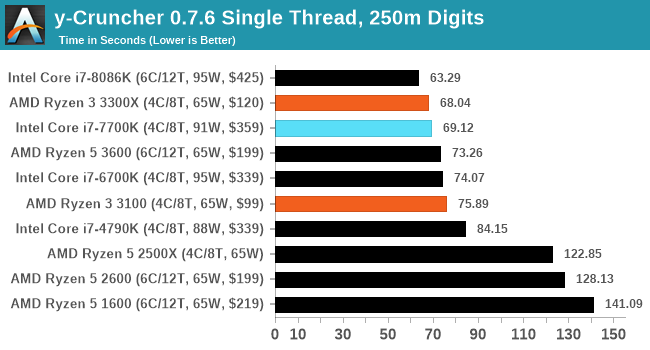
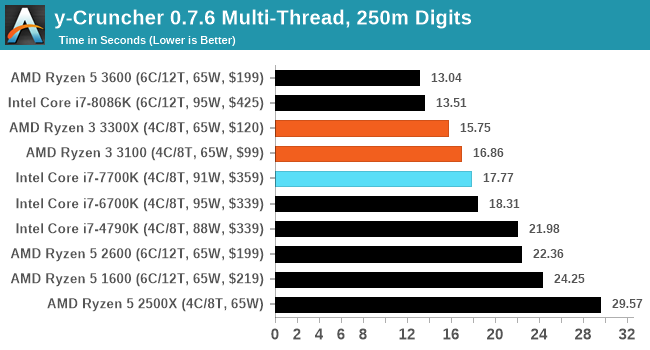
Agisoft Photoscan 1.3.3: 2D Image to 3D Model Conversion
One of the ISVs that we have worked with for a number of years is Agisoft, who develop software called PhotoScan that transforms a number of 2D images into a 3D model. This is an important tool in model development and archiving, and relies on a number of single threaded and multi-threaded algorithms to go from one side of the computation to the other.
In our test, we take v1.3.3 of the software with a good sized data set of 84 x 18 megapixel photos and push it through a reasonably fast variant of the algorithms, but is still more stringent than our 2017 test. We report the total time to complete the process.
Agisoft’s Photoscan website can be found here: http://www.agisoft.com/













249 Comments
View All Comments
Spunjji - Monday, May 11, 2020 - link
The issue is that it's not informed. It's codswallop.PeterCollier - Monday, May 11, 2020 - link
You're talking about the article.Spunjji - Tuesday, May 12, 2020 - link
🤡psychobriggsy - Thursday, May 7, 2020 - link
Considering it shows the $120 AMD offering comprehensively beating the old i7-7700K, and says the current Intel budget offerings will be slower, and recommends the AMD processors, I find this comment rather brain dead.WaltC - Thursday, May 7, 2020 - link
One question I had is why AT chose to use the 2600 instead of the 3600...? Makes no sense to me, as the 3600 runs at 65W and the 3600X runs at 95W--just like the 2600--only the 3600 is appreciably faster--but costs the same! 3600 is MIA. No question but that the review benchmarks clearly demonstrate the superiority of the AMD offerings, but we already knew that. I see the omission here--deliberate--of the 3600--while including $425 Intel 6c/12t offerings--as surely an apology for Intel's inability to compete. Such is not needed, really. Apologizing in subtle ways for Intel is, I think, a pretty poor way to write a review on CPUs Intel cannot at the present time compete with--the 3100/3300. Getting right down to it--there was no need to include *any* 6c/12t CPUs here, right? Should have been comparisons only with Intel/AMD 4c/8t cpus, exclusively, imo. Selection of CPUS for *this review* didn't make any objective sense that I could see--beyond the obvious, of course (at least you didn't forget and leave the 3100/3300 out...;))evilspoons - Thursday, May 7, 2020 - link
I'm guessing the omission of the 3600X has something to do with, at the time I read this, they hadn't even finished all the benchmarks for the 3100. You know, the one in the headline. I don't think it's a conspiracy, just a time constraint.crimson117 - Thursday, May 7, 2020 - link
They didn't rerun the 2600 for this, they used existing benchmarks.They haven't ever benchmarked the 3600 previously, so it's not listed here. They do have the 3700X, however, which is essentially the same performance as a 3600 (except in heavily threaded workloads): https://www.anandtech.com/bench/product/2520?vs=25...
MDD1963 - Thursday, May 7, 2020 - link
I saw other testers on Youtube use the 3600, and, the 3300X was VERY surprisingly close to it's performance...; the 3300X's clearly quite strong threads and lack of inter -CCX -RAM latency issues are reaping benefits!BenSkywalker - Thursday, May 7, 2020 - link
The choices they use to compare are utterly bizarre. A three and a half year old Intel i7 and last generation Ryzen parts....?Legitimately, this review is useless if you are shopping *today*, not just from a team red versus team blue, but where this processor sits in today's market, no clue after reading this. One of my friends was looking for a budget gaming build and I was looking at a 3200G/B450 setup, how does this compare? Instead let's assume people have a time machine and are cross shopping two gen old Ryzen and three green old Intel parts....?
The charts aren't bad, they are terrible. Have an old i7 in there for reference, ok, put current Ryzen 3 and i3 inn there and if you don't have enough time *only* include them.
rabidpeach - Friday, May 8, 2020 - link
bro, they try to make a point with the reviews. if you want this comparison you use the cpubench feature of this website and compare any chip they tested on any of the tests they have. it's an actual feature not a bug. the point of this article and tests is to show entry level amd 100 price point is as powerful as 3 year old flagship-ish intel for the mainstream. it shows against the zen and zen+ hexacores that it catches up to them in many situations despite lacking in cores. this shows you amd is not just throwing cores at intel anymore. they have ipc too! ok any more spoon-feeding? would you prefer a spork?